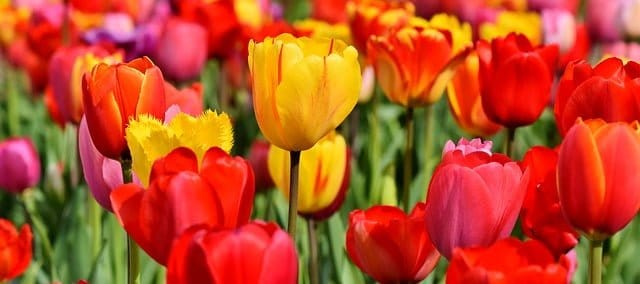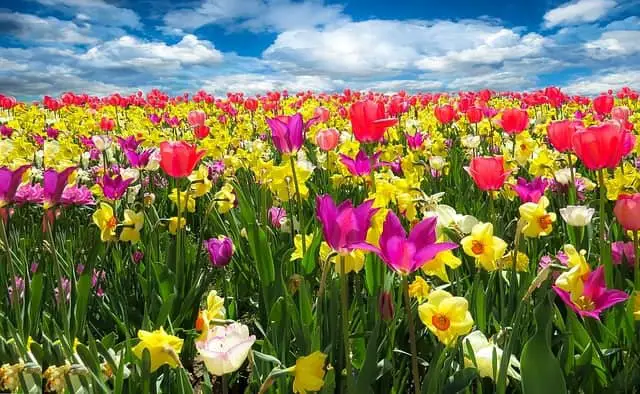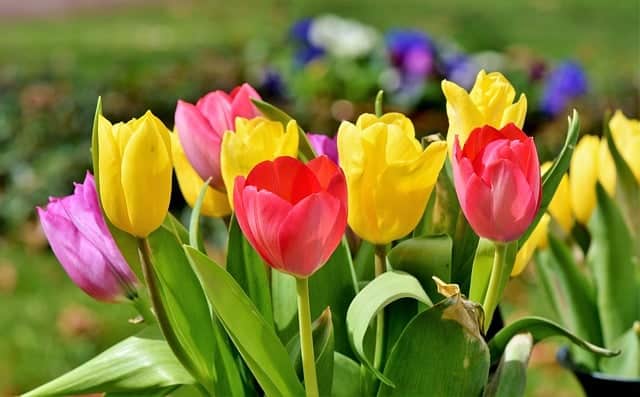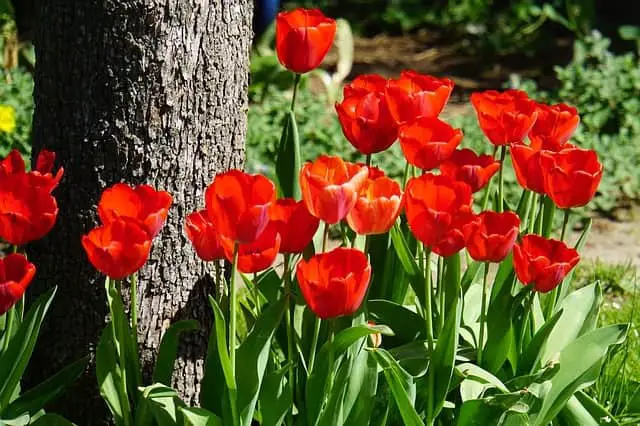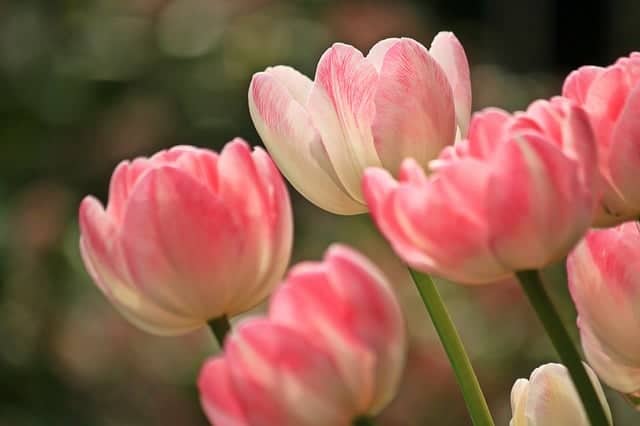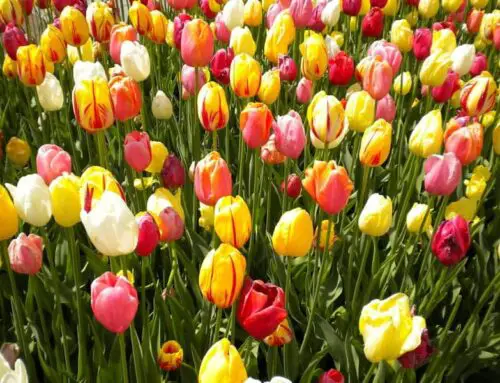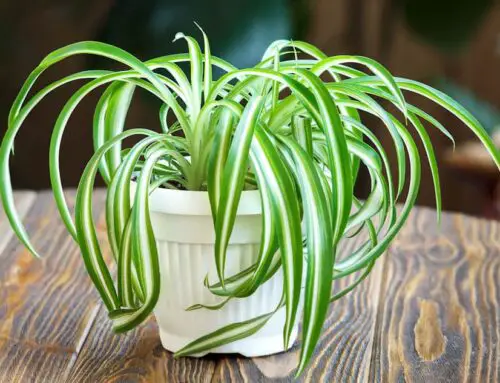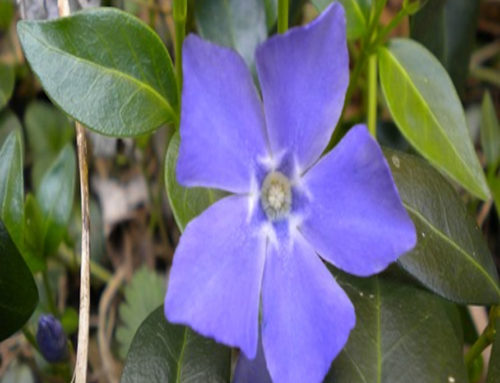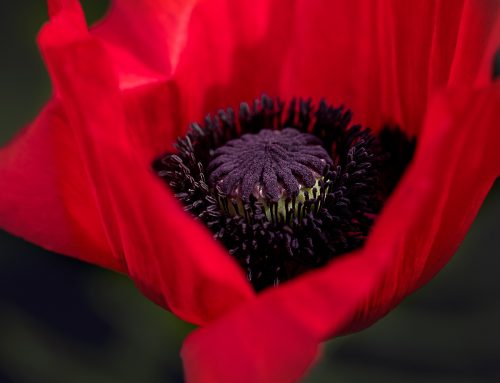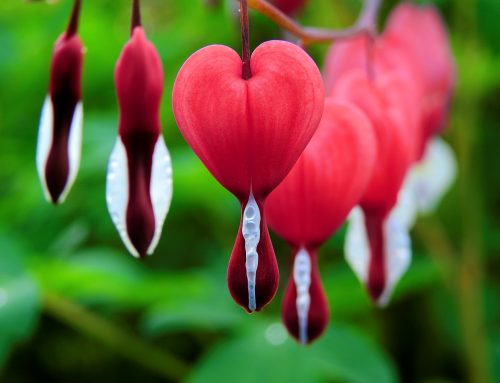The tulip is synonymous with spring, brightly colored tulip blooms accent gardens all around the world.
Tulips are an extremely popular perennial flower due to their ease in growing – with minimal care and upkeep; they grow beautifully in most garden settings.
They come in a variety of colors, plant heights, and flower shapes making them extremely versatile for any garden space.
Tulip Facts
- Scientific Name – Tulipa sp.
- Life Cycle – Perennial
- Soil pH – 6.0 – 7.0
- Plant Hardiness – USDA Zones 3-8
- Light Requirements – Full Sun/Part Sun
- Water Requirements – Low
- Fertilizer Demand – Low
- Planting Date – Fall
- Flowering Season – Early Spring
- Height – 6″ – 2′
- Colors – Almost Every Color
- Pests – Mold, Bulb Rot, Aphids, Slugs, Snails
- Propagation – Division
How to Grow Tulips
Tulips are classified as perennial plants, but their life cycle is dependent on the hardiness zone where they are planted. Being native to Central Asia, tulips are predisposed to climates where there are long winters and a cooler spring.
Therefore they require a cold winter to continue to bloom in successive years. Tulips will “perennialize” best in zones 7 or colder. This process is known as vernalization: plants need about 8 – 10 weeks of soil temperatures registering between 45 – 50°F and then a climactic rebound to warmer temperatures to produce a flower bud.
Because of this it may be best to treat tulips as annuals in areas where winter temperatures do not drop for sustained periods of time. While planting new bulbs every fall may get tedious, it will ensure continuous blooms every spring.
Tulips Bulbs Care
Bulbs should be planted in the fall, 6 -8 weeks before a hard frost is anticipated for the area. This ranges from September to October depending on the growing area. Tulips prefer sunny spots in the garden, but need some partial shade in zones that have higher daytime temperatures and more intense sunlight.
They do not like their roots to be wet so look for sites with well-drained soil that is slightly acidic to neutral. Work the garden site well, adding in broken down compost a few inches below where the bulbs will be planted.
Then plant tulip bulbs approximately 8” below the soil surface, and space them 4 – 6” apart. Water the bulbs well after planting to help trigger their growth.
Tulip Care
Tulips are fairly drought tolerant and do not need much water, other than what they receive from rainfall. Because of this, irrigation systems can be detrimental to tulip beds. It’s best to route water lines around the beds to keep the soil from being too wet as this abundant moisture encourages bulb rot.
Tulip plants also don’t require much fertilizer; a yearly addition of compost to the soil will provide everything the plants need for optimal growth and will also help to improve soil drainage.
Tulip Pests
Too much water is the enemy of tulips, and many of the pests and diseases that affect plants are related to damp conditions. Gray mold and bulb rot are the two most common disease afflictions; both of which are mostly preventable by keeping soil moisture controlled and avoiding overwatering. When plants are infected the treatment is removal of any affected plant material.
Tulip plants are typically attacked by pests correlated to wet conditions such as:
- Aphids
- Slugs
- Snails
Rodents are particularly fond of tulip bulbs and preventative measures should be put in place to deter these creatures.
- Voles
- Mice
- Rabbits
- Squirrels
Types of Tulips
Tulips come in many different colors and sizes, there are many different types of tulips that will look great in a tulip garden.
Single Early Tulip:
Are the ones you usually see in the beginning of spring. They come in all different colors and grow between 6 and 18 inches tall.
Double Early Tulip:
Have more petals then the single early version. They come in reds, pinks, oranges, yellows, and white. They usually grow around beginning to mid spring and grow up to 12 inches tall.
Darwin Hybrid:
Grow in mid spring and have a pyramid shape to them. They come in many bright colors such as pink, yellow, orange, and red.
Triumph Tulip:
Also grow in mid spring. They are very large and grow to 14 to 24 inches. They come in a wide variety of colors.
Single Late:
Is another tall version of this flower. They can be anywhere from 24 to 30 inches tall. The flower itself has an oval shape to it. They also come in a wide variety of colors.
Fringed Tulip:
Named for the way they look. The edge of the petals are fringed. They come in purple, pink, red, white and yellow. They grow 14 to 26 inches tall.
Lily Flowered:
A beautiful look to it. The petals are pointy shaped, and open up like a delicate looking flute. They come in all kinds of colors.
Parrot Tulip:
The Parrot Tulip has a different look. They have fringed petals that open wide. This type comes in bright colors and is very large.
Greigii Tulip:
Blooms in mid spring and the flower stand straight up at attention. The petals do not spread out far when opened.
Viridiflora:
Flowers are 16 to 21 inches tall. They are also called green tulip because of the green streak on their leaves.
Double Late:
Are full flowers with a large bloom. They bloom in late spring and are 14 to 24 inches high.
Rembrandt:
Have strange looking marks on them. They are from a virus that was spread onto the plants.
Fosteriana:
Blooms in mid spring and has large flowers. They look very tall and can grow to be 12 – 18 inches tall.
Kaufmanniana:
Have a very large blossom. They bloom in mid spring.
Tulip Mania
Now we can’t have a page about tulips without mentioning Tulip Mania. During the 1630s the people in the Netherlands began to really like tulips. Their beautiful vibrant colors attracted people and tulips became a must have luxury item.
At the start people bought and sold tulips normally giving money in exchange for the tulips. Eventually as demand increased for tulips the price skyrocketed. Tulips began to be traded the same way stocks are traded today.
With the rise in prices speculators began to buy tulips at the end of the season. They did not receive the tulips. They were buying on the premise that the price of tulips would continue to rise in the future and be worth more than what they originally bought them for. This was buying in a futures market.
It became a tulip mania where buyers and sellers were rapidly buying and selling pieces of paper without anyone actually receiving any tulips. In 1637 the demand for tulips suddenly stopped. The prices for tulips crashed into the ground and they became worthless. Anyone still holding a purchase contract for tulips lost a lot of money when the bubble suddenly burst.
Tulip Conclusion
Available in many gorgeous colors and shapes, tulips are a fantastic accent in many gardens. They grow as annuals in warmer climates and perennials in areas where winters get cold enough for vernalization. Needing very little water, and little fertilizer, they are an easy plant to put into a garden space for early to mid-spring blooms.

